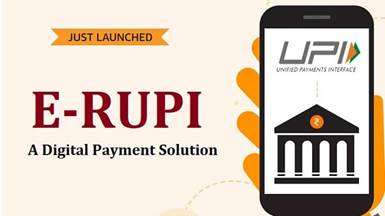Description

Disclaimer: Copyright infringement not intended.
Context
- The Reserve Bank of India (RBI) has finally launched its pilot programme for the e-rupee, India's own Central Bank Digital Currency (CBDC).
What Is CBDC?
- CBDC is a digital currency that is issued by the central bank of a sovereign nation. By definition, it is freely convertible against the physical currency issued by the same central bank. Similar to physical currency, one need not have a bank account to transact using CBDCs either.
- However, one major distinguishing factor between CBDCs and physical currency is that CBDCs will have an infinite life, in the sense that they cannot be damaged or lost in any physical form. It will be managed on a digital ledger that may or may not be blockchain-enabled.
Features of Digital Rupee
1) CBDC is a sovereign currency issued by central banks in alignment with their monetary policy.
2) It appears as a liability on the central bank’s balance sheet.
3) It must be accepted as a medium of payment, legal tender, and a safe store of value by all citizens, enterprises, and government agencies.
4) CBDC is freely convertible against commercial bank money and cash.
5) CBDC is a fungible legal tender for which holders need not have a bank account.
6) CBDC is expected to lower the cost of issuance of money and transactions.

Types of CBDCs
- CBDCs can be of two types: retail (CBDC-R) and wholesale (CBDC-W). The wholesale kind would be used for interbank settlements and other wholesale transactions whereas CBDC-R would be used for retail transactions as an electronic form of cash. CBDC-W is expected to reduce transaction costs and make interbank markets more efficient. The RBI pilot program that began on November 1 2022 is for CBDC-W alone.
- Another pilot program for CBDC-R is expected to start by next month. Presently, several other central banks across the world are exploring the possibilities of putting CBDCs into practice.
In a nutshell,
Retail CBDC
- Retail CBDC can be used by all including the private sector, non-financial consumers, and businesses. Wholesale CBDC is designed for restricted access to select financial institutions.
- Retail CBDC can provide access to safe money for payment and settlement as it is a direct liability of the central bank.
Wholesale CBDC
- While retail CBDC is an electronic version of cash primarily meant for retail transactions, the wholesale CBDC is designed for the settlement of interbank transfers and related wholesale transactions.
- Wholesale CBDC has the potential to transform settlement systems for financial transactions and make them more efficient and secure. Going by the potential offered by each of them, there may be merit in introducing both CBDC-W and CBDC-R.
How is Digital Rupee different from money in digital form?
- A CBDC would differ from existing digital money available to the public because a CBDC would be a liability of the Reserve Bank, and not of a commercial bank.
Why is RBI introducing CBDC?
- CBDC is aimed to complement, rather than replace, current forms of money and is envisaged to provide an additional payment avenue to users, not to replace the existing payment systems.
- RBI believes that the digital rupee system will "bolster India’s digital economy, enhance financial inclusion, and make the monetary and payment systems more efficient."
Pointing out the motivations for India to consider issuing CBDC, RBI mentioned these reasons:
- a) Reduction in cost associated with physical cash management
- b) To further the cause of digitisation to achieve a less cash economy.
- c) Supporting competition, efficiency, and innovation in payments
- d) To explore the use of CBDC for improvement in cross-border transactions
- e) Support financial inclusion
- f) Safeguard the trust of the common man in the national currency vis-à-vis proliferation of crypto assets
CBDCs around the World
- A study by Atlantic Council Geo Economics Center has found that close to 105 countries are considering the possibility of launching a CBDC that would be primarily used for interbank transactions. From an estimated 35 nations in as recently as 2020, this is a significant jump.
- About 19 of the Group of Twenty (G20) countries are exploring the issuing of CBDCs and most of them have made progress beyond the initial research stage.
https://indianexpress.com/article/business/banking-and-finance/rbi-to-kickstart-e-rupee-pilot-in-g-secs-today-8241470/
















